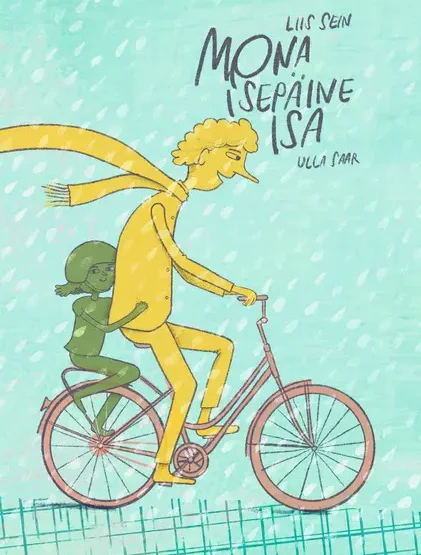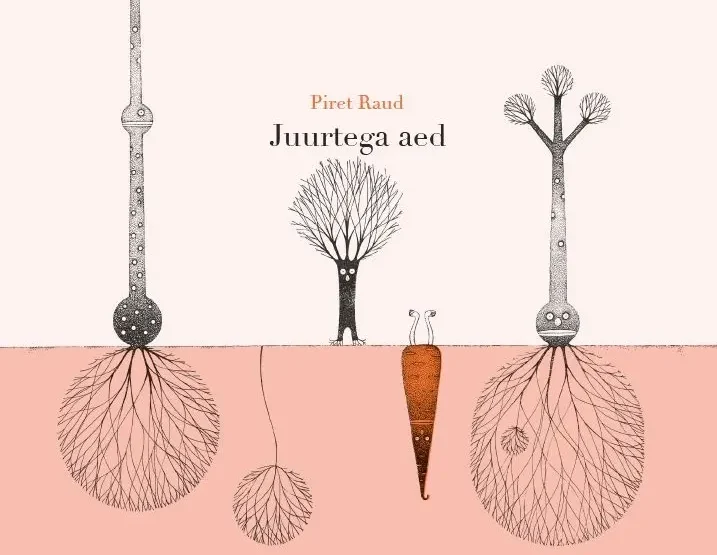Kairi Look’s first children’s book, Ville the Lemur Flies the Coop, was published in 2012. The author herself could very well be that lemur, as she left Tallinn years ago to settle in Paris, and later Amsterdam.
Or perhaps it’s more correct to say that Look (b. 1983) divides her time between Estonia and the Netherlands. With such frequent travel, airplanes are a necessary mode of transportation between the two capitals, which means many hours spent wandering through airports. And so, perhaps, it is no surprise that Look’s debut was followed by another children’s book titled The Airport Bugs Fight On (2014). After her second book, it wasn’t long before Look’s bright and busy character Piia Biscuit came to life in what is currently a series of three books: Piia Biscuit Moves In (2015), Piia Biscuit and the Bandits (2019), and Piia Biscuit and the Word-Snatcher (2021). This year, Look published her ninth book: Herring Disco, which is likewise populated by odd and unusual characters. Her earlier works have been translated into several other languages: German, Polish, Finnish, French, Lithuanian, Latvian, and Russian.
What kind of a writer is Kairi Look?
“I write the way I live: searching the world for light and believing in freedom, the energy of motion, and openness. I always choose to see hope and solutions, and I admire courage. I honestly believe in a bright tomorrow.”
Of course, the world isn’t always so rosy.
“I do not cross out sadness when I write. Darkness is no stranger and I am very much drawn to it, to the abyss of the human psyche portrayed in literature. Difficult, grim topics in kids literature can be addressed with empathy and through a prism of humor. Estonia can be a rather bleak and difficult place to live during the dark months—literature offers an escape and there’s a lot you can do with humor. I love absurdity and have a sharp eye for silliness in society. Jokes are a great way to cast light on such things. Kids like how funny and down-to-earth my books are and adults enjoy the finer extra layer.”
Although Look graduated in physical therapy, she imagined herself as a researcher or a health journalist from the very beginning. While completing her master’s degree in Amsterdam, she ended up working as a science publisher for a non-fiction publishing house and realized that it’s possible to write about many other things.
“I regard Amsterdam as my second home because that’s where I started to think that it’s all possible. It was easier for me to dream and to believe in those dreams there. I’ve written many books in that city.
“I’ve worked in medicine and publishing, but literature was the path that swept me along immediately and has been dear to me since childhood. A lot of it comes from my great-grandmother, who read to me all the time. She was born in 1902 and lived with us until I was nine. She was very important to me, instilling in me the belief that you can handle anything. Lately, I’ve been thinking about her and the influence she had on me more and more.”
The World can be Made Better
The characters in Look’s books are tolerant, open-minded, and curious. They’re active and clever, be they lemurs or bed bugs—not to mention Piia Biscuit herself. Piia comes across as an ideal child who sails her way through life. Although her environment is safe and secure, that doesn’t mean it’s uneventful or free of any danger—there remains much to be resolved.
Look believes that children’s books need not be unbreakable, entirely risk-free, or without melancholy because life is not a simple piece of cake and it would be boring if it was. Melancholy is also an appropriate subject. What matters is to offer children a safe, understanding anchor from which they can explore, discover, and get a little wild.
The author doesn’t dwell upon morals when writing for younger audiences. She’s neither a parent nor a teacher. Rather, she aims to encourage children to forge connections with the world around them. “I treat kids as equals and try to impart the belief that they have the power to change things, especially in light of our modern-day climate crisis; where the world is going off-kilter.”
Look believes there’s an opportunity to see good in every difficult situation and that there’s no need to play the victim or surrender helplessly to the way things are. Dialogue is a useful tool. “If you look at kids, then they possess an openness and the ability for expressful communication from birth. As adults, we sometimes tend to become rigid, generalizing, and analytical. But, at the end of the day, we are polyphonic human beings. Courage to be vulnerable opens a door to the human soul, to dialogue, to connecting in depth.”
She writes whenever the impulse comes calling, which means not just every day. But when she does (and for her, writing is an innate practice), then it’s a natural flow and a reflection of her values and convictions. She’s fond of children’s literature because it is an unquestioned abode for genuine joy, warmth, and humor. It’s where she feels at home as well.
Still, Look wouldn’t be herself if she were limited to only one genre and, lately, she’s been writing more short fiction and literary reviews. Having received a three-year Estonian writer’s salary, Look is using the opportunity to focus exclusively on writing. Next up is a full-length novel for adults.
“I’d like to write a little differently for kids, too. These three years are for experimentation. In the future, I’ll definitely do something aside from writing—I’m too curious to sit at a desk all day. I mean, where else will I get subject matter for writing, anyway?”
At the Intersection of Three Languages
Living in several different countries gives you a whole new perspective. For instance, one might refrain from making hasty judgements or defining themselves or others with a single label such as “writer”. The world is a complex and dynamic place that is rich in its diversity.
Although Look lives at the intersection of three languages—Estonian, Dutch, and English—she finds it very important to write in Estonian. She’s also translated several Dutch children’s books into her native language, including works by Annie M. G. Schmidt and Annet Schaap.
“Translating presents a lot of challenges; it teaches you things and helps you to develop. Working in Dutch and being a conduit for Estonian and Dutch culture are things I truly enjoy. Annie G. Schmidt and I share a similar style, so translating her work was easy. Annet Schaap is more lyrical and poetic, which meant more difficulty but also excitement.”
Look has never met a child who doesn’t like being read to or told a story. If children read literature that they enjoy, then it’s likely they’ll continue reading into adulthood. You just have to find the right book. Illustrations are in no way trivial, either.
The author’s books have been illustrated by Elina Sildre, Kirke Kangro, Marge Nelk, Kaspar Jancis, and Ulla Saar. As an author, she usually refrains from interfering in the artists’ work. Look has developed a close mutual understanding with Saar, who has brought the author’s colorful characters to life while adding a dose of her own humor. Saar’s contributions include the Piia Biscuit books and Herring Disco.
“Illustrations craft a whole world around a book. Ulla prizes openness, tolerance, and curiosity, just like I do. My books have many unique characters who are all a little bizarre, though they each have the right to stay themselves. The way Ulla commits them to paper is amazing. In the future we’ll surely create picture books together, where the synergy between the author and illustrator is especially crucial.”
As someone who walks boundaries, Look values freedom and living however the heart desires.
“I don’t belong to just any one place, and I like treading boundaries. I feel very much Nordic and love Estonia, but I also appreciate the anonymity that Amsterdam offers, its openness and diversity. I believe that the world is a better place when we try to understand each other and preserve a plurality of opinions, show our vulnerability, and seek for connection. I believe in joy, hope, the power of curiosity and a bright tomorrow where also our darkness can reside. Life is always worth living.”
Annika Koppel (b.1964) is the editor-in-chief of Estonian Literary Magazine.





